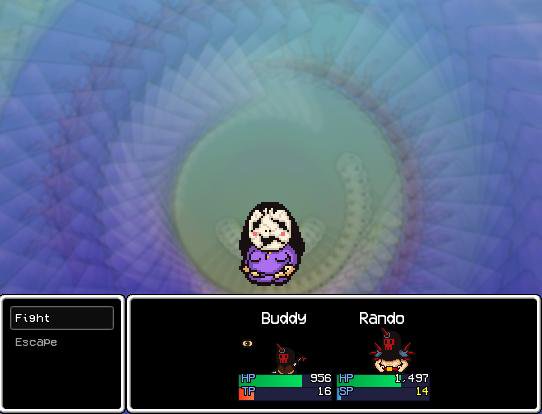

Description: In Lisa: The Joyful, Buddy fights Mr. Beautiful, the warlord of Olathe. Mr. Beautiful wears a mask, and as he sustains damage, the mask slowly cracks. When it falls off, the otherwsie pacifistic Mr. Beautiful finally strikes back, attacking Buddy and her party.
->Thought One: This is a mechanic because it indicates to the player how much health Mr. Beautiful has left: the more cracked the mask, the more damage. ->Thought Two: This is clearly indicates a the passage through the "forms" of the boss, a well-known RPG mechanic--see, for example, Sephiroth's three forms.
->Thought One: The actual cracking of the mask does not indicate a form change. The visual design of Mr. Beautiful does not necessarily in-and-of-itself map to the form of Mr. Beautiful. In fact, one could imagine a version of Mr. Beautiful in which there is no final form, or form transitions, and in which the cracking of the mask is merely garnish to give the player an extra feeling of accomplishment.
->Thought Two: That last argument is theoretical (lol, @ me (lol , can't @ people on blogs)), but it does, to a degree, apply to Mr. Beautiful. Until the mask actually comes off, Mr. Beautiful's behavior does not change. He remains passive and a pacifist. Therefore, the two times that the mask cracks, but does not break, do not indicate a changing in form or in mechanics. It truly is mere garnish.
->Thought Three: But, then there's finally this: this isn't a fight that the player can reasonably lose. Mr. Beautiful does not fight bacl. Even if it indicates how much damage Mr. Beautiful has sustained, and we consider that a mechanic in itself, it is a non-mechanic mechanic, because it has no implications for the player. It does not, in any reasonable way, change player behavior; it does not impact the player save through its visual design.
->Thought Four: Which is to say: it does a damned good job looking like a form transition in a more straightforward RPG. But, Lisa is by no means straightforward. This is an idea mimic of sorts, and a particular breed therein: the mechanic mimic, something which only looks like a mechanic from afar.
->Thought One: Sure, but get this: it may be a meta-mechanic. I have mentioned meta-mechanics before on here, and it's something that I am thinking about. This is something with no mechanical purpose in game, but which, nevertheless, may impact player decision, but only for players who have not played the game before. It is a mechanic that falls apart when the player knows other mechanics. Which means that it is a mechanic contingent upon player understanding of mechanics: it is a second order mechanic.
->Thought Two: Also, if we consider everything that is within the magic circle to be a mechanic, then those things which bring players into the magic circle are themselves mechanics. The magic circle is the liminal space of play--okay, forive me, my art history background is showing--the anthropological area in which ruls of normal society are suspended and instead replaced with the rules of the game. The cracking of the mask invests the player in the game, and brings them more intimately into the magic circle. This opens a whole can of worms, but maybe a can of fun worms, because this would apply that all visual design decisions are themselves mechanics, though in a meta-sense. For example, then: is the process of picking players for your team in pickup basketball or playground dodgeball a mechanic, because it is part of the process of bringing a player into the system and of defining the ruleset that they will follow (by identifying who is on their team and who is not)? Maybe. I was not good at sports. That's why I blog.
->Thought Three: Here's my take. It is a meta-mechanic that relies on previous player knowledge of the idea that boss fights in RPGs should have forms, and in doing so takes a fight which is a non-fight, and which would bore the player, potentially ejecting them from the magic circle, and makes it feel like a fight. Oh, I may be able to insert Zizekian ideology into this, but I won't. But, the fight only looks like a fight, the cracking of the mask only looks like the transition of forms, but by looking like these things so well, and so well-emulating what a mechanic should look like, it becomes a meta-mechanic of sorts.